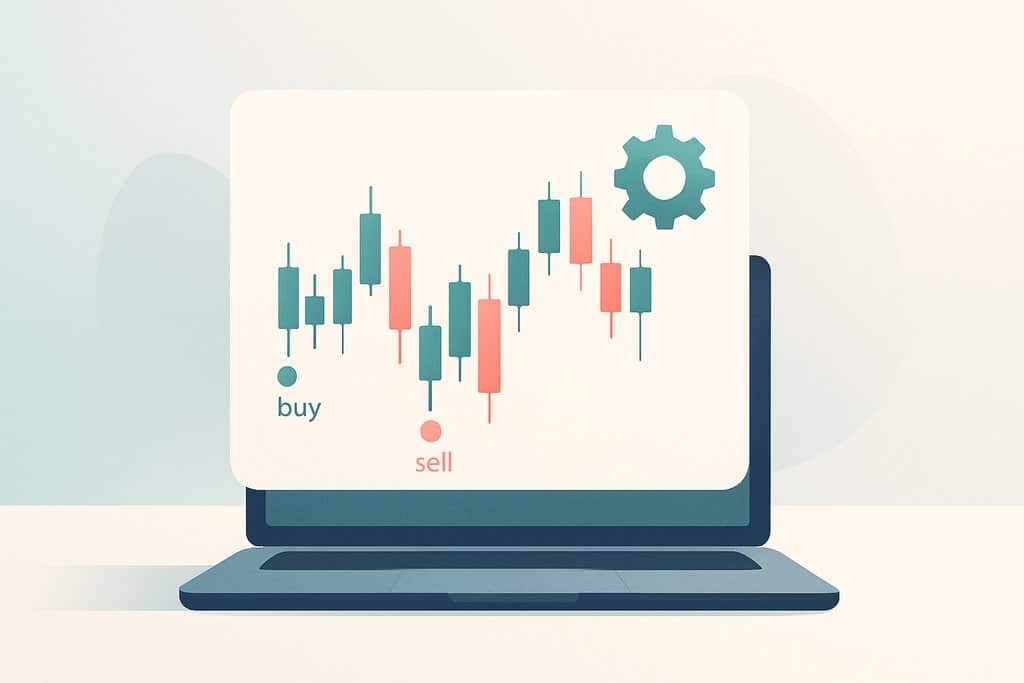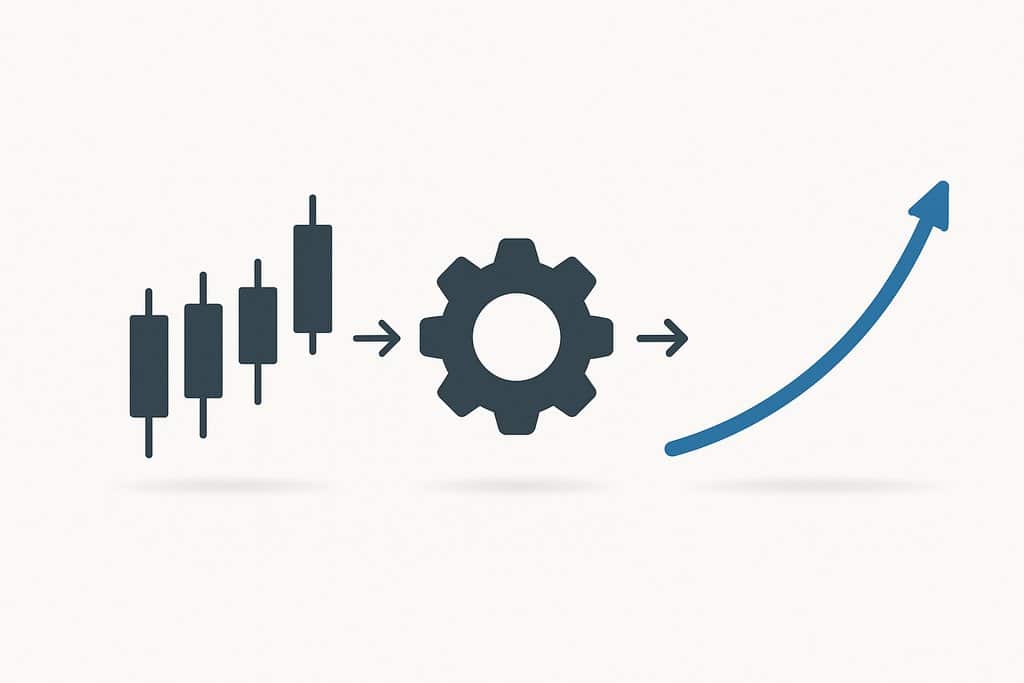Automated Trading: What It Is, How It Works & Start
Learn how automated trading works, why it matters, and how to launch robust, no-code strategies that execute your rules with speed and discipline.

Table of contents
- What is automated trading
- Why traders adopt automated trading today
- Inside an automated trading system
- Signal design that survives the real world
- Execution quality, slippage, and costs
- Risk management for automated systems
- A practical workflow
- Three automated trading examples
- Benefits and considerations
- Getting started today
- FAQs
- Related articles
Automated trading attracts traders for a simple reason. Markets move too fast for manual execution, and emotions often ruin otherwise solid plans. If you have ever missed an entry because you were away from the screen, chased a trade after a sudden spike, or failed to cut a loss, you already know the problem automated trading tries to solve. You want a system that listens to your rules and acts instantly and consistently. That is the promise.

What is automated trading
Automated trading is the use of predefined rules and software to place and manage trades without manual intervention. You design the logic that generates signals and manages risk, then a system executes orders on your behalf when market conditions match those rules. In practice, this can range from a simple alert that prompts a manual click to a fully automated strategy that opens, manages, and closes positions across multiple markets.
Two terms often overlap: automated trading and algorithmic trading. In most contexts they refer to the same idea, although some practitioners use algorithmic trading to emphasize the quantitative process that generates signals, while automated trading emphasizes the hands-free execution layer. For a concise overview, see Investopedia’s definition of algorithmic trading.
Automated trading systems typically include four building blocks. First is data, such as prices, volumes, fundamentals, news, or macroeconomic events. Second is signal logic, the rules that decide what to buy or sell and when. Third is execution, the process that translates a signal into orders with the right type, size, and routing. Fourth is risk control, for example stop losses, position sizing, and daily loss limits. When these blocks work together, you get an always-on process that screens markets and acts the moment your conditions are met.
Why traders adopt automated trading today
The appeal of automation has grown across retail and professional segments because markets are information dense and time constrained. Crypto trades 24 hours a day, and even traditional assets react within seconds to earnings, economic prints, or breaking news. Humans do not scale well across multiple watchlists or time zones. Automated trading, when designed carefully, offers advantages that are hard to replicate manually.
- Speed of execution that stays consistent at any hour
- Emotional discipline that enforces rules without bias
- Simultaneous monitoring across prices, indicators, and news
Speed is not only about latency. It is about consistency. The same rule will execute the same way at 3 a.m. as it does at 3 p.m. Emotional discipline follows from that consistency. When a stop triggers, the system exits. When a signal is missing one condition, no trade is placed. Finally, automation lets you monitor hundreds of instruments and several types of information at once. You can watch prices, technical indicators, company announcements, and even macro news in parallel, then trigger actions in real time.
Inside an automated trading system: signals, execution, and feedback
Signals
Although many traders imagine automated trading as a black box that needs heavy coding, the structure is straightforward. A signal is just a rule. For example, you might buy when the 50 period moving average crosses above the 200 period moving average and the relative strength index is below 70. Or you might sell when a headline mentions new tariffs on a sector you hold. The key is precision. If your signal is ambiguous, the system cannot decide, so you must translate ideas into unambiguous conditions.
Execution
Execution is more than pressing buy or sell. You need to define order types, slippage assumptions, and fail-safes. Market orders fill quickly but can suffer poor prices in volatile conditions. Limit orders improve price control but can miss fills if you set them too aggressively. Many automated traders blend the two with limit orders that use a small offset and a timeout that converts to market after a short delay. Trailing stops, profit targets, and partial take profits should be encoded upfront, not adjusted on the fly.
Feedback
Feedback closes the loop. Your system should log every decision, track realized costs like commissions and slippage, and feed that back into your research. If a signal works on paper but suffers in live execution, you either adapt the execution layer or adjust the signal to produce fewer trades in congested conditions. This cycle of design, test, deploy, and refine separates a hobbyist bot from a robust automated strategy.
Platforms now make this cycle accessible without code. Obside is a financial automation SaaS that turns plain-language instructions into concrete market actions. Instead of writing scripts, you describe what you want to do in chat, and Obside Copilot generates alerts, places orders, or manages portfolios according to your rules. For a broader perspective on AI-driven workflows, see AI Trading: Turn Signals into Automated Market Actions. You can say, alert me if Bitcoin rises above $150,000 and daily volume doubles, or buy $1,000 of Bitcoin if the price is below $100,000. You can also build multi-condition strategies with indicators and timeframes, then backtest them in seconds with Obside’s ultra-fast engine. That ability to move from idea to execution quickly was recognized by the Innovation Prize 2024 at the Paris Trading Expo.
If you want more background on the field, Wikipedia’s overview of algorithmic trading adds historical context and strategy types across asset classes.

Signal design that survives the real world
The hardest part is not automating a rule. It is designing a rule that holds up outside the backtest. Good signal design respects three principles. First, it uses information that is timely and robust. Indicators like moving averages and RSI are common because they are simple and reflect price behavior that many watch. Event-driven signals can be powerful as well if the events are clear and the data source is reliable. For example, if Apple announces a new product, you may want to get notified and then fade or follow the move depending on historical patterns.
Second, good signals balance sensitivity and selectivity. If your rule triggers constantly, it will rack up transaction costs and noise trades. If it triggers rarely, it may not be actionable in live markets. Tune this balance through parameters like lookback windows, thresholds, and filters that exclude low-volume or high-volatility periods.
Third, good signals are testable and reproducible. If you cannot test it, you cannot trust it. This is where a fast backtesting workflow helps. With Obside, you can describe a strategy like buy when there is a bullish divergence on RSI on a 15 minute chart, set a stop loss on the low of the day, and take profit at 10 percent. Obside will simulate it on historical data in seconds. You can adjust thresholds and see how the equity curve, drawdowns, and win rate change, then lock the parameters before going live. For deeper principles, read Trading Strategy: Build, Test, and Automate Rules That Last.
Execution quality, slippage, and costs in automated trading
A strategy that looks profitable on paper can struggle in production if execution is sloppy. Slippage is the difference between your intended price and your actual fill. It can come from spread width, order book depth, or delays in routing. To manage it, match your order type to your market conditions. If you trade liquid large-cap stocks during regular hours, limit orders near the bid or ask can reduce slippage without hurting fill rates. If you trade thin altcoins or news spikes, a smart marketable limit with a small offset may capture momentum while capping the worst price deviations.
Transaction costs also matter. Commissions, exchange fees, and financing can erode edge, especially in higher-frequency systems. Always include realistic costs in your backtests. Survivorship bias and look-ahead bias can inflate results as well. Survivorship bias occurs when your historical dataset omits delisted or failed assets. Look-ahead bias occurs when your strategy uses information that was not available at the time. Both can be mitigated by careful dataset selection and platform safeguards.
Finally, be mindful of latency between your signal trigger and order placement. If your system uses external data like news or macroeconomic prints, you want a platform that can process and act on those events quickly. Obside ingests market data, technical indicators, and even news or macro data, then triggers your actions in real time. That means you can encode rules like sell your stocks if new tariffs are announced or buy oil when a hurricane hits, without writing integration code yourself.
Risk management for automated trading systems
Risk management is where automated trading often shines compared to manual execution. Because rules are explicit, you can enforce limits mechanically. Position sizing scales your trade to your risk per setup. You can size by fixed fractional risk, such as 1 percent of account equity per trade, or volatility-adjusted sizing that uses an indicator like ATR to scale positions smaller in choppy markets and larger in quiet markets. Stops should be placed where your thesis is invalidated, not where the loss feels comfortable. Trailing stops can protect gains while letting winners run.
Portfolio level controls add another layer. If your system runs multiple strategies, cap the total exposure to a sector or factor. If daily drawdown exceeds a threshold, pause trading for the day. These are simple rules that reduce the chance a single outage or regime shift inflicts a crippling loss.
One practical method is regime detection. Many strategies perform differently in trending versus ranging markets. You can use a higher timeframe filter, such as the Supertrend on the 8 hour chart, to gate entries on a lower timeframe like the 2 hour chart. If both are aligned, you take signals. If not, you wait. In Obside you can encode this logic in plain language, then add a trailing stop based on 5 times the ATR on the 2 hour chart. When the Supertrend flips, the position is closed automatically.
A practical workflow: idea to automation in days, not months
A reliable process matters more than any single strategy. Think in stages. First, express your idea clearly. Write one paragraph that states the market, timeframe, signal, risk, and exit. For example: buy $50 of Bitcoin every Monday at 10:00 a.m., add a 20 percent catastrophic stop just in case, and otherwise never sell. This is dollar cost averaging, and it is easy to automate.
Second, test the logic. Use a backtester that includes fees, slippage, and realistic data. Tweak parameters to see if results are stable across small changes. If a strategy collapses when you shift a parameter by 10 percent, beware overfitting.
Third, paper trade. Run the strategy in simulation against live data. Confirm that signals, fills, and logs match your expectations. A dedicated guide like Paper Trading: Complete Guide to Practice Strategies can help you set up a clean workflow.
Fourth, go live with small size. Monitor both performance and execution metrics. Expand size gradually as confidence grows.
Alerts: “Notify me if RSI crosses 70 on EUR/USD and MACD turns bearish.” Actions: “Buy $50 of Tesla if Elon Musk tweets about it.” Strategies: “Keep 50% BTC, 25% ETH, 25% USDC and rebalance monthly.”
Obside compresses these steps. You use Obside Copilot to describe your logic in natural language, like notify me if RSI crosses 70 on EUR/USD and MACD turns bearish. Then you click to convert that alert into an automated action, such as sell a portion of my EUR/USD position. You can also make event-driven rules, such as alert me if Apple announces a new product or tell me when OpenAI announces a new AI model, then decide whether to trade based on your playbook. When you are ready, connect your broker or exchange in Obside, backtest your full strategy in seconds, and switch from alerts to automated execution. For a builder’s view, see AI Trading Bot: What It Is and How to Build One That Trades.
Three concrete automated trading examples
Consider a momentum strategy in crypto. Your rule might be to buy when price closes above the 20 period high on a 2 hour chart, provided RSI is below 70, and the 8 hour Supertrend is bullish. You set a stop at 5 times the 2 hour ATR and take profit on a trailing basis. In Obside, you can phrase this as when the Supertrend becomes bullish on the 2 hour chart, if RSI is not overbought and the Supertrend on the 8 hour chart is also bullish, buy. For selling, reverse the logic and add a trailing stop. Backtest this logic on several coins, analyze drawdowns, then deploy it on a small allocation.
Next, an event-driven approach for equities. Suppose you want to hedge if the S&P 500 drops 10 percent from the recent high. You would encode a rule to sell all positions if the S&P 500 drops by 10 percent. You might also add a news trigger like sell your semiconductor ETF if new tariffs are announced. Because Obside can listen to both price conditions and news, it becomes straightforward to build these hedges.
Finally, a portfolio automation example. Say you want to maintain 50 percent in Bitcoin, 25 percent in Ethereum, and 25 percent in USDC. You can define a rule that rebalances monthly or when deviations exceed a threshold. If volatility spikes, you might lower risk temporarily or add a stop on the crypto sleeve. This is where automation helps with discipline. The rebalancing happens even if you are away.
Benefits and considerations of automated trading
The benefits are clear. Automation removes hesitation and enforces rules. It scales your attention across markets and timeframes. It runs 24 hours a day, which matters for crypto and for reacting to global events. With a platform like Obside, you can go from idea to backtest to live deployment in minutes instead of weeks, and you can combine price, technical, and event triggers without writing code.
There are considerations to respect. Data quality is critical. Bad data yields bad signals. Overfitting is the most common mistake. If you optimize a strategy too tightly to the past, it will underperform in the future. Use out-of-sample testing, cross-validation, and keep the number of parameters modest. Market regimes change. A strategy that works in a trend may struggle in a range, so add filters or diversify across strategies. Technical failures can occur as well. Always include kill switches, max daily loss limits, and alerts that notify you if something goes off script. If you want to broaden your toolkit, explore Quantitative Trading: Build, Test, and Automate Strategies.
Getting started today
If you are new to automated trading, start small and build confidence. Write down one rule you already trade manually. Translate it into clear conditions, a stop, and an exit. Backtest it with realistic costs. Paper trade it for a week. Then automate it with minimal size. This cycle compounds your learning quickly.
For a no-code path, try Obside. Visit the platform at beta.obside.com, describe your rule in Obside Copilot, run a fast backtest, and deploy it with your broker or exchange connection. You can also explore the marketplace where traders share strategies, or keep it private and customize for your needs. Learn more about the platform on the site: obside.com.
FAQs
What is the difference between automated trading and algorithmic trading?
Both terms are often used interchangeably. Many traders use algorithmic trading to emphasize the quantitative process that creates signals, and automated trading to emphasize the hands-free execution of those signals. In practice, most modern systems do both, from signal generation to risk and execution.
Do I need to know how to code to start automated trading?
No. While coding offers flexibility, there are platforms that remove the need to write scripts. With Obside, you describe what you want in plain English and the system translates it into alerts or automated actions. You can still control indicators, thresholds, stops, and portfolio rules, then backtest and deploy without code.
How much capital do I need for automated trading?
You can begin with small amounts, especially if your broker or exchange allows fractional orders. The key is to size trades so that a typical loss is a small percentage of your account, often 0.5 to 1 percent. Focus on process and risk control first, then scale when you are confident in live results.
How do I avoid overfitting when I build automated strategies?
Keep your rules simple and grounded in market logic. Test on one period, validate on a different period, and include fees and slippage. Use parameter ranges instead of a single perfect value. If small changes in parameters break the strategy, it is likely overfit. Paper trade before going live.
Can automated trading react to news or macro events, not just price and indicators?
Yes. Event-driven trading is a growing area. With a platform like Obside, you can trigger actions based on company announcements, policy headlines, or economic data. For example, alert me if Apple announces a new product, or sell part of my portfolio if new tariffs are announced.
Which markets are best suited for automated trading?
Any liquid market with reliable data can be automated. That includes equities, forex, futures, and crypto. Your strategy should match the market’s characteristics. Higher volatility and 24 hour trading in crypto demand robust risk controls and round-the-clock monitoring, which automation provides. To explore market styles and tactics, see Types of Trading: Strategies, Styles, and Examples.
